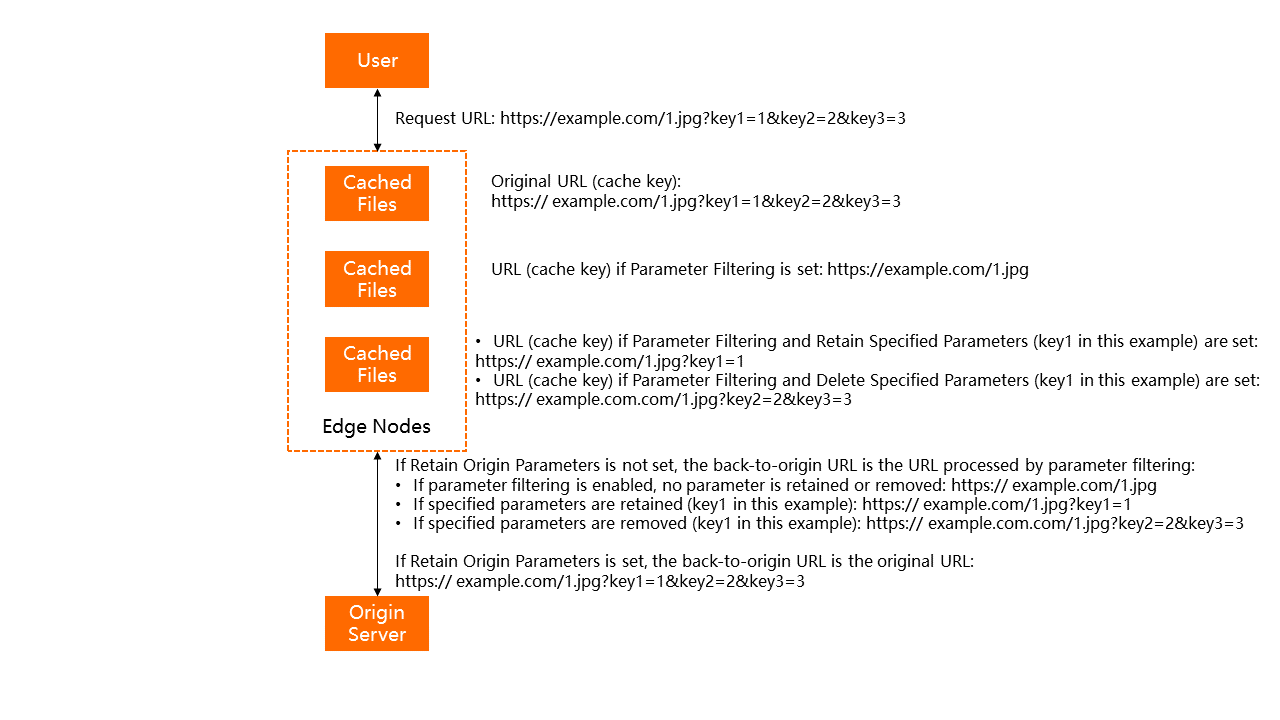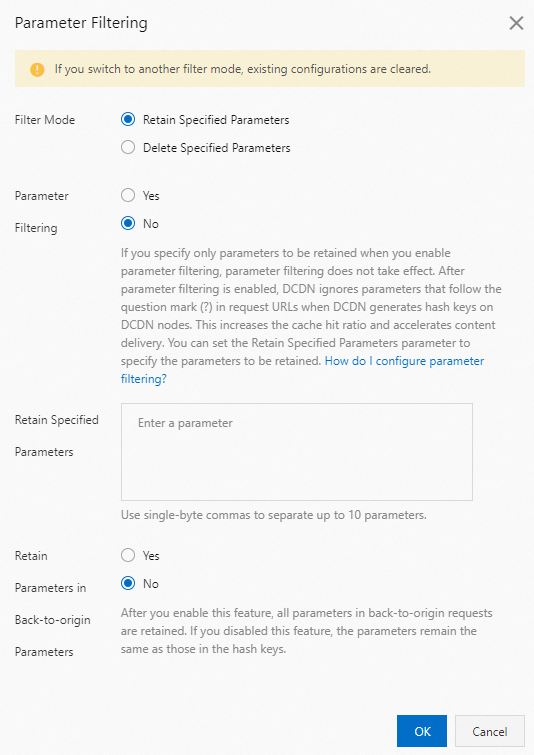After you enable the parameter filtering feature, Alibaba Cloud Dynamic Route for CDN (DCDN) can remove parameters that follow the question mark (?) in the request URLs. This improves the cache hit ratio, reduces the number of requests that are redirected to the origin server, reduces the costs of back-to-origin data transfer, and accelerates content delivery. This topic describes how to configure the parameter filtering feature.
Background information
- Enable parameter filtering
If your request URL contains a question mark (
?) followed by parameters, such ashttp://alibaba.com/content?a, but a low priority is assigned to the parameters and content can be retrieved even if the parameters are ignored, we recommend that you enable the parameter filtering feature. If you enable the feature, DCDN ignores the parameters that follow the question mark (?) in the request URL when resources are retrieved from the origin server. This increases the cache hit ratio.For example, the first time you visit
http://example.aliyundoc.com/image_01.jpg, the requested resource is not cached on DCDN points of presence (POPs). DCDN retrieves the resource from the origin server. The second time you visithttp://example.aliyundoc.com/image_01.jpg?test1, the parameters that follow the question mark (?) in the URL are ignored because parameter filtering is enabled. The request can directly hit the cached resourcehttp://example.aliyundoc.com/image_01.jpg. - Disable parameter filtering
If your request URL contains a question mark (
?) followed by parameters, but the parameters contain important information, we recommend that you disable the parameter filtering feature. After the feature is disabled, DCDN checks the entire URL, including the parameters that follow the question mark (?). Exact matches increase the accuracy of content retrieval.For example, the first time you visit
http://example.aliyundoc.com/image_01.jpg, the requested resource is not cached on DCDN POPs. DCDN retrieves the requested resource from the origin server. The second time you visithttp://example.aliyundoc.com/image_01.jpg?test1, the parameters that follow the question mark (?) are retained because parameter filtering is disabled. DCDN checks the entire URL. The request cannot hit the cached resource because the request URL is different fromhttp://example.aliyundoc.com/image_01.jpg. The request is redirected to the origin server to retrieve the resource athttp://example.aliyundoc.com/image_01.jpg?test1.
Features
- Parameter filtering
Description Scenario DCDN removes the parameters that follow the question mark ( ?) in request URLs so that requests that are destined for the same file but carry different URL parameters can hit the cache. Parameter filtering increases the cache hit ratio, reduces the back-to-origin routing frequency, and accelerates file distribution.Some users append parameters after the question mark ( ?) in request URLs to pass information such as user IDs (UIDs), request sources, and recommendation codes to the origin servers. In this case, these URLs carry different query strings even if the requests are sent to the same file.We recommend that you enable parameter filtering if the parameters that follow the question mark (?) in URLs are irrelevant to the requested resource. Examples:- Request from User A:
http://example.com/1.jpg?uid=123*** - Request from User B:
http://example.com/1.jpg?uid=654***
After parameter filtering is enabled, the DCDN POP removes the UIDs that follow the question mark (
?) in the request URLs. The final URLhttp://example.com/1.jpgis used to match against the cache. - Request from User A:
- Retain parameters in back-to-origin requests
Description Scenario The original URLs are redirected to the origin server so that key user information can be passed to the origin server. If you enable parameter filtering, DCDN POPs redirect the URLs processed by parameter filtering to the origin servers. In the preceding example, the requests from User A and User B both use the URL http://example.com/1.jpg. The UIDs are not passed to the origin server during back-to-origin routing.If parameter filtering is enabled, DCDN POPs redirect the original URLs to the origin server so that the UIDs are passed to the origin server.

Procedure
- Log on to the DCDN console.
- In the left-side navigation pane, click Domain Names.
- On the Domain Names page, find the domain name that you want to manage, and click Configure in the Actions column.
- In the left-side navigation pane of the domain name, click Optimization.
- In the Parameter Filtering section, click Modify, select a filtering mode based on your business requirements, and then set the parameters. Note If you change the filtering mode, the current configuration is cleared.
- Filter Mode: Retain Specified Parameters

Parameter Description Example Parameter Filtering - Yes: DCDN removes the parameters that follow the question mark (
?) in the request URL when resources are retrieved from the origin server. This increases the cache hit ratio.Note If you enable Parameter Filtering and do not set the Retain Specified Parameters parameter, all parameters that follow the question mark (?) are removed. - No: DCDN checks the entire URL, including the parameters that follow the question mark
?. Exact matches increase the accuracy of content retrieval.
If the original URL is http://example.com/1.jpg?key1=1&key2=2&key3=3, the following examples show how the URL is processed based on different settings:- Example 1: remove all parameters and redirect the final URL to the origin server.
- Parameter settings: Parameter Filtering is set to Yes, no value is specified for Retain Specified Parameters, and Retain Origin Parameters is set to No.
- Cache key:
http://example.com/1.jpg. - URL redirected to the origin server:
http://example.com/1.jpg.
- Example 2: retain specified parameters and redirect the final URL to the origin server.
- Parameter settings: Parameter Filtering is set to Yes, Retain Specified Parameters is set to
key1, and Retain Origin Parameters is set to No. - Cache key:
http://example.com/1.jpg?key1=1. - URL redirected to the origin server:
http://example.com/1.jpg?key1=1.
- Parameter settings: Parameter Filtering is set to Yes, Retain Specified Parameters is set to
- Example 3: remove all parameters and redirect the original URL to the origin server.
- Parameter settings: Parameter Filtering is set to Yes, no value is specified for Retain Specified Parameters, and Retain Origin Parameters is set to Yes.
- Cache key:
http://example.com/1.jpg. - URL redirected to the origin server:
http://example.com/1.jpg?key1=1&key2=2&key3=3.
- Example 4: retain specified parameters and redirect the original URL to the origin server.
- Parameter settings: Parameter Filtering is set to Yes, Retain Specified Parameters is set to
key1, and Retain Origin Parameters is set to Yes. - Cache key:
http://example.com/1.jpg?key1=1 - URL redirected to the origin server:
http://example.com/1.jpg?key1=1&key2=2&key3=3.
- Parameter settings: Parameter Filtering is set to Yes, Retain Specified Parameters is set to
Retain Specified Parameters You can specify up to 10 parameters that you want to retain. Separate multiple parameters with commas (,). Retain Origin Parameters - Yes: retains all parameters in URLs during back-to-origin routing.
- No: retains only specified parameters in URLs during back-to-origin routing. The parameters are the same as those in the cache key.
- Yes: DCDN removes the parameters that follow the question mark (
- Filter Mode: Remove Specified Parameters

Parameter Description Example Delete Specified Parameters You can specify up to 10 parameters that you want to remove. Separate multiple parameters with commas (,). If the original URL is http://example.com/1.jpg?key1=1&key2=2&key3=3, the following examples show how the URL is processed based on different settings:- Example 1: remove specified parameters and redirect the final URL to the origin server.
- Parameter filtering: Delete Specified Parameters is set to
key1, and Retain Origin Parameters is set to No. - Cache key:
http://example.com/1.jpg?key2=2&key3=3. - URL redirected to the origin server:
http://example.com/1.jpg?key2=2&key3=3.
- Parameter filtering: Delete Specified Parameters is set to
- Example 2: remove specified parameters and redirect the original URL to the origin server.
- Parameter settings: Remove Specified Parameters is set to
key1, and Retain Parameters in Back-to-origin Requests is set to Yes. - Cache key:
http://example.com/1.jpg?key2=2&key3=3. - URL redirected to the origin server:
http://example.com/1.jpg?key1=1&key2=2&key3=3.
- Parameter settings: Remove Specified Parameters is set to
Retain Origin Parameters - Yes: retains all parameters in URLs during back-to-origin routing.
- No: removes only specified parameters in URLs during back-to-origin routing. The parameters are the same as those in the cache key.
- Example 1: remove specified parameters and redirect the final URL to the origin server.
- Filter Mode: Retain Specified Parameters
- Click OK.